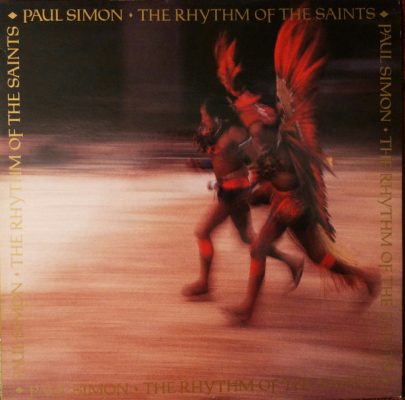Paul Simon’s follow-up to Graceland is about 75% as good as Graceland and suffers from comparison to Graceland at every turn and here’s a fourth Graceland.
It has many excellent moments, and certainly tries hard enough to to be a big event (it’s stacked with Latin American percussion ensembles, and the production credits list a mind-numbing eighty-six names). But although it can survive being worse than its predecessor, it also can’t escape it.
Graceland, aside from being a pop monster, had weight behind it. Launched in the face of a boycott, it tackled political subjects like apartheid, racism, slavery, and classism, along with Simon’s personal issues – his divorce, his deathspiraling career, etc. It was saying something.
Rhythm of the Saints, by comparison, says little. “I Can’t Run” has a verse about the Chernobyl disaster (nearly five years in the past by then) that doesn’t fit with the rest and has apparently wandered into the lyric sheet by mistake. “Born at the Right Time” snarls peevishly about overpopulation (“Too many people on the bus from the airport / Too many holes in the crust of the earth / The planet groans / Every time it registers another birth”). “The Cool, Cool River” seems to be about environmentalism. It’s half-hearted jabs flung in every direction, few landing with much force.
And given that Graceland had sold over ten million copies by this point, Simon isn’t a scrappy underdog anymore; he’s a mega-selling music phenomenon throwing his weight around. The go-for-broke audacity of the last album is gone. Now he comes off as a rich white guy paying Brazilian drummers to spice up his pop songs.
Paul Simon never musically justifies why he’s doing this, or why he’s chosen to explore this new style. Graceland borrowed from everywhere, but it had a method to it. The intimacy and sweetness of the early Simon and Garfunkel felt mirrored in the mbanqa and township jive of South Africa – with its lavish vocal harmonies and communal aspect – and the links between slave music and 1960s folk/rock are almost too obvious to mention. It all fit together.
By contrast, the showboating tribal drumming of Rhythm of the Saints feels calculated and even cynical on Simon’s part. He’s trying to turn Graceland into a formula he can re-use again and again. “Pop songs, fused with [your country here’s]’s music”. If the cards had fallen differently, we’d be hearing Paul Simon playing guitar along with Mongolian throat singers or Malay gamelan orchestras. It’s just unmotivated exoticism.
The songs are mostly good, leaning as they do into rhythmic textures rather than singalong pop hooks. “The Obvious Child” is the obvious lead single. “Proof” hits hard. “I Can’t Run” is the best song: anxious, itchy, desperate to move but stuck in place. There’s an altered version on In The Blue Light which is also good but sad: it replaces the chicotes and castanets with an orchestral, and in doing so exposes how unnecessary the Latin American elements were to the song.
Rhythm of the Saints was commercially lifted by the aftershocks of Graceland. It shifted a lot of copies upon release (and it was soon certified double-platinum), but its sales rapidly died away. Three singles were released; all of them flopped. These are the typical signs of an album that isn’t selling on its own merits but is instead riding a wave.
I’m too hard on Rhythm of the Saints. It’s huge, elaborate, and detailed. Simon clearly cared deeply about this album, and tried to make it as good as it could possibly be. But through it all is the sound of an artist grasping and scratching to a ragged mountain peak, and finally losing his grip. He can’t help but fail a little. When you’re at the top of Everest, where else can you go except back down to the base camp?
No Comments »
Comments are moderated and may take up to 24 hours to appear.
No comments yet.

